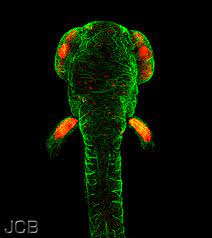Abstract
Neural crest cells (NCCs) give rise to various tissues including neurons, pigment cells, bone and cartilage in the head. Distal-less homeobox 5 (Dlx5) is involved in both jaw patterning and differentiation of NCC-derivatives. In this study, we investigated the differentiation potential of head mesenchyme by forcing Dlx5 to be expressed in mouse NCC (NCCDlx5). In NCCDlx5 mice, differentiation of dermis and pigment cells were enhanced with ectopic cartilage (ec) and heterotopic bone (hb) in different layers at the cranial vertex. The ec and hb were derived from the early migrating mesenchyme (EMM), the non-skeletogenic cell population located above skeletogenic supraorbital mesenchyme (SOM). The ec developed within Foxc1+-dura mater with increased PDGFRα signalling, and the hb formed with upregulation of BMP and WNT/β-catenin signallings in Dermo1+-dermal layer from E11.5. Since dermal cells express Runx2 and Msx2 in the control, osteogenic potential in dermal cells seemed to be inhibited by an anti-osteogenic function of Msx2 in normal context. We propose that, after the non-skeletogenic commitment, the EMM is divided into dermis and meninges by E11.5 in normal development. Two distinct responses of the EMM, chondrogenesis and osteogenesis, to Dlx5-augmentation in the NCCDlx5 strongly support this idea.
Introduction
Neural crest cells (NCCs) are mesenchymal cells that originate from the dorsal part of neural tube by epithelial-to-mesenchymal transition. NCCs then migrate to different regions of the embryo, where they give rise to various cell types such as bone and cartilage of the skull, sensory neurons, pericytes, melanocytes and smooth muscles1. NCCs and paraxial mesodermal cells (MES) cooperatively form the craniofacial structure. NCCs contribute to the rostral craniofacial skeleton including the pharyngeal skeleton while MES give rise to caudal cranium2,3,4. The boundary between NCC and MES in the calvarium corresponds to the coronal suture between the frontal and parietal bones3,4,5.
The NCC is accurately regulated by a complex gene network from the appearance to migration and differentiation1. Distal-less homeobox 5 (Dlx5) is expressed early at the neural plate border for establishing the area of NCC delamination, but it does not control NCC specification or migration1,6. Dlx5 is required for patterning and differentiation of the NCC7. Expression of Dlx5 and its co-functional member of the Dlx gene family, Dlx6, are involved in jaw patterning8,9. In jaw development, Dlx5/6 works downstream of Endothelin1 (Edn1), localized in the mandibular process while Dlx5/6 are absent in the maxillary process8,9,10,11,12. Double knock-out of Dlx5/6 in mice causes mandible transformation into maxilla-like structure8. Reversely, forced Dlx5 expression in NCCs in mice (NCCDlx5) induces ectopic Dlx5 expression in the maxillary process leading to upregulation of mandibular-specific genes and appearance of several phenotypic hallmarks of the mandible in the maxilla region11.
Dlx5 is also expressed in differentiation stages of NCC-derivatives: ganglion of cranial nerves, cartilage and bone13,14. In osteoblast differentiation, Dlx5 is induced by BMP signalling, then Dlx5 enhances Runt-related transcription factor 2 (Runx2), a master transcriptional regulator for osteogenesis15,16,17. DLX5 directly binds to SP7, a downstream of Runx2, to promote osteoblast differentiation18. Calvarial osteoblasts isolated from Dlx5 deleted mice show reduced proliferation and differentiation19. Dlx5 is also expected to induce recruitment of fibroblasts to chondrogenic lineage and chondrocyte maturation in the chick20,21. In mice, the calvarium and chondrocranium malformations have been shown to associate with Dlx5-downregulation7,22,23. Meanwhile, cranial base cartilages derived from NCC are enlarged by Dlx5-overexpression, but calvarial bones have not been examined11.
In calvarial development, formation of the frontal and parietal bones start with the aggregation of mesenchymal cells in the area of the supraorbital ridge at embryonic day (E) 10.53, referred to as the supraorbital ridge mesenchyme5,24,25,26 or supraorbital mesenchyme (SOM)27. The SOM proliferates and differentiates into osteoblasts from E11.5, then intrinsically expands to the apex of the head to form the bone from E13.54,5. Importantly, due to the intimate association and mutual support of cranial bones and the dura mater, the defects in the dura mater affect calvarial bone formation and maintenance28,29,30,31. Before the SOM begins apical growth, a population of head mesenchyme, termed as early migrating NCC32 or early migrating mesenchyme (EMM)27, is established above the SOM to contribute to the sutures or soft tissue layers such as the dermis and the meninges4,25,32. Transcriptome analysis revealed that the SOM and the EMM exhibit different gene expression profiles by E12.533, and the development of the skull vault is achieved by interactions between the apical (EMM) and basal (SOM) cell populations28. Although the EMM is normally non-osteogenic, previous reports demonstrated that the EMM can generate bone in genetic disorders27,32.
NCC-specific Dlx5-augmentation results in a switch of the jaw identity11, but the effect on NCC differentiation potential has not been examined. In this study, we further investigated the effect of Dlx5-overexpression in NCCs with special reference to early development and differentiation potential of the EMM.







